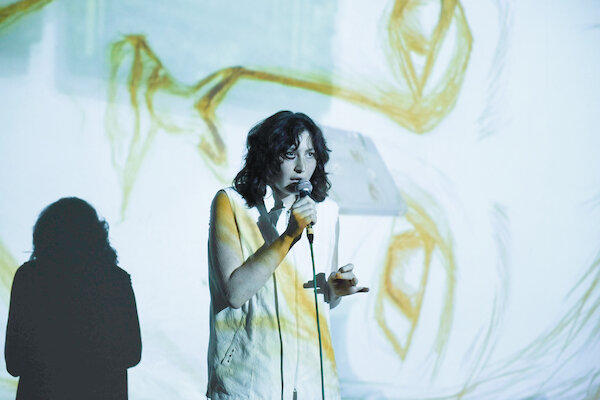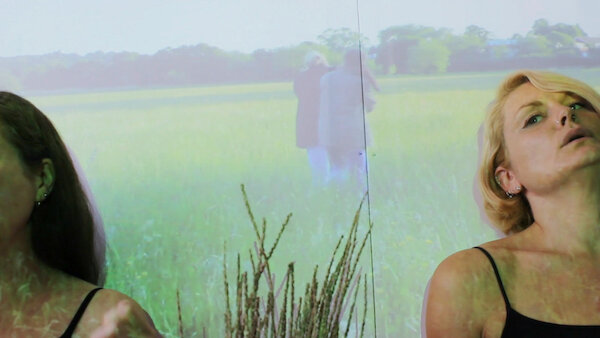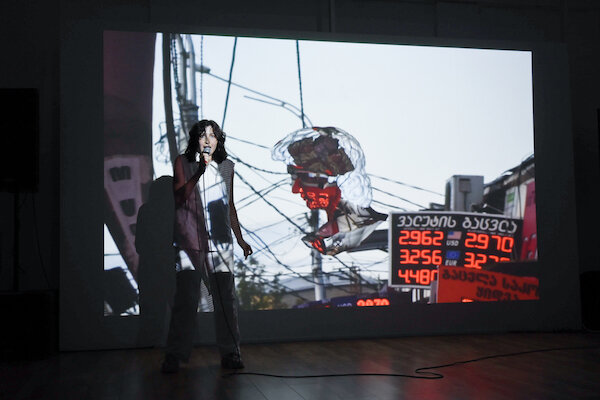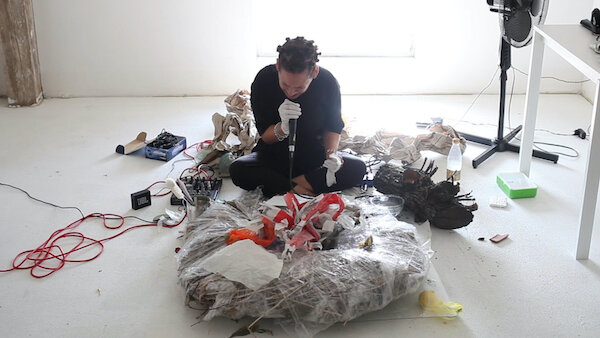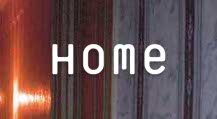Three practitioners respond to SLANT’s first event, Voiceworks
Lola Nieto
The voices speak and the poem listens. The poem is an air stage. A channel that steers noise and gives an audible shape to the mist. The voices are not understood. The poem recreates a cloth, a tapestry, a net where the voices are visible. Sometimes not recognisable, but visible. On September 13th and 14th, Voiceworks put six outbreaks on stage.
LMB weaves two worlds. Projection on a screen of two bodies touching and losing each other. In the foreground, two cut women produce sound but it is not noticed how their mouths generate it. Another sound lives outside of the field. It is a game between the invisible-visible, the deaf-audible. Bodies inside and outside. Voices in/out.
The voice is a psychosomatic effect in two directions, says Serena Braida. The voice registers two directions: the tragic and the parodic. Does anyone listen?
The mouth is not the only generator of sounds. The body lives and speaks roars. Air is an instrument, like someone who plays a transparent theremin. Richard McReynolds turns his body into a mouth. The movement of the skin modifies, repeats, distorts, transforms the voice caressing the air. Communication loses the words. Emotion is a search for disfigurement. Although there is nothing in the hands, they seem to be noise animals.
Emma Bennett extends a set of voices in disjointed conversation. What is communicated? What is said? What is understood? Is it an echo? What voice is the original? There is no origin.
Sound textures. A two-faced language. On the screen: real images and drawn lines. Anamaria Burduli: footprints.
Kinga Tóth is a shaman. Her oracle: cables and plastic, microphone and looper. The voices of the dead come through technology. A bowl of water. A trunk. A stone. There are no more instruments. Nature and acceleration. Rite and dementia. Her plastic-wrapped face is only revealed when multiple voices find their way into her. When voice is an alien tool, it delivers the mark of strangeness on the tongue.
Voiceworks shows that the poem does not live in lines of black ink on white, but in the throat, in the rock and moss cave of the voice. Voiceworks also suggests that women's voices lead in experimentation today.
Nicol Parkinson
Lisa Busby’s blurting turntable interjections place me in three spaces at once, watching their screen on my screen upright in bed. I screen, you screen. It seems strange that online presentation of sonic work defaults to video. Performance removed from the visual signpost language of the café or early evening nightclub. Freed from previous confines or sent back to our bedrooms? Consonant rubbings of outside hands, clasping contact of inside hands. Louder. The varispeed soundworld has a language of its own. I find myself distracted by MP3 artefacts, as I would be by the breath of the man sat behind me, the hum of the bar fridge, my feet sckrunching in their shoes. Delight in bureaucratic cruelty sSHhhh HARD in headphones. Accompaniment as prop, pillar or juxtaposition? If technology does not enhance the idea, reject immediately. Emma Bennett’s transformation of a silently sounding object into text into sound BLANKSCREEN. The unfamiliar organ, repeatedly replaced. Words turn to rhythmscrambles, finally an ideal situation. Each item which surrounds Kinga Tóth is essential, every gesture floats in essential stasis.
Mark Leahy
Beginning with Bennett where the phatic interaction of a dialogue points at, suggests, almost tells us in its description of a photographic image, avoids the proper name with few nouns the (two?) voices tell a control panel, and apparatus of / for manipulation, the desk or synthesiser or organ we get an impression of through the assembly of vocal / verbal fragments, a phenomenology of touch see feel sense accumulates in the to and fro of the voice(s) (they’re the same?) so we see /not quite/ supported by a series of almost images on screen, again /not quite/ visible (il)legible information.
Then Burduli whose performance was full -- a visual sonic collage moving and swirling and imagery (photographic / graphic / comic) was projected over the performer, she squished into the lower left corner of the screen – back to the wall – made small in the face of the spill of colour and pattern, she speaks and hums and sings, building layers of voice, sounds, rhythms, repetition gathers to form a sound world where this listener hears some words in English, some in another (other) languages (ss) (sszs), sees some faces / places/ words - ‘Georgia’; different textures come into play, harmony and disharmonics across a linguistic field as folds and echoes take us elsewhere.
And thirdly Tóth performing with materials and tech, a voicing body sits at the centre of a mess of stuff, she generates sounds, vocal, verbal, and made with the things around her, layering these up using a looping pedal, building texture and density with added voicing – anger, pain, frustration are moaned and cried and wailed and shouted through shreds of material; some words are read (in English) at the heart of this, a chant to exorcise the power of Orban, to rescue arts and culture in Hungary from a rush rightwards, the sounds resist, strain to push against this hate.
Three performances moving across a range of vocal verbal sounding, (1) a disintegration of the word, through a sequence of sense (phatic / half unsaid / almost uttered) that (2) slips or skips to sung and hummed in multilingual drone / rhythm and then (3) to cry moan and wail as the performance shifts to the (mainly) expressive with some sung / spoken words at the centre. The performances explore meaning, feeling, acting and sounding in a range of voiced noises, communicating otherwise.

